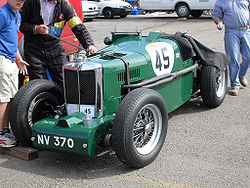- MG Q-Type
-
MG Q-Type (QA) Hersteller: MG Produktionszeitraum: 1934 Klasse: Rennwagen Karosserieversionen: Monoposto
BipostoMotoren: 0,75 l-R4-Kompressor, 146 bhp (107 kW) Länge: 3632 mm Breite: 1346 mm Höhe: Radstand: 2388[1] mm Leergewicht: Vorgängermodell: - Nachfolgemodell: MG R-Type Der MG Q-Type oder MG QA war ein Rennwagen, den MG 1934 herstellte. Das Fahrwerk beruhte auf dem des K3 Magnette, war aber schmäler und hatte die Achsen des NA/NE Magnette[2]. Der Motor hatte des Block des PA/PB Midget, aber eine andere Kurbelwelle für einen Hubraum von 746 cm³, wobei der Hub von 83 mm auf 71 mm reduziert wurde[3]. Es gab auch eine Sprint-Version, deren Leistung 146 bhp (107 kW) erreichte, was einer spezifischen Leistung von nahezu 200 PS/ltr. entsprach. Dies war damals die höchste spezifische Leistung eines Motors auf der ganzen Welt[4].
Vermutlich wurden nur acht Exemplare gefertigt (Sedgewick spricht von neun), denn die Wagen waren mit 550-650 £ sehr teuer[5] und die Starrachsen hatten Schwierigkeiten, mit der Motorkraft fertig zu werden. Die einsitzige Version erreichte mit George Harvey-Noble als Fahrer eine Rundengeschwindigkeit von 195 km/h in Brooklands, der Zweisitzer immerhin noch 192 km/h[6].
Weblinks
- Foto und kurze Beschreibung des MG Q-Type (englisch)
- Foto: Kenneth im MG Q-Type in Donington Park am 14. Juli 1934
Einzelnachweise
- ↑ Blower, W.E.: MG Workshop and Tuning Manual, Motor Racing publications, London (1952)
- ↑ Sedgewick, M.: A-Z of Cars of the 1930s, Bay View Books, Devon (1989), ISBN 1-870979-38-9
- ↑ Allison, Mike: The Magic of MG, Dalton Watson, London (1972), ISBN 0-901564-095
- ↑ Georgano, N.: Beaulieu Encyclopedia of the Automobile, HMSO, London (2000), ISBN 1-57958-293-1
- ↑ Green, Malcolm: MG Sports Cars, CLB, Godalming (1997), ISBN 1-85833-606-6
- ↑ Sedgewick, M.: A-Z of Cars of the 1930s, Bay View Books, Devon (1989), ISBN 1-870979-38-9
MG-ModelleAktuelle Modelle: 3 | 350 | 550 | 6 | 7 | 750 | TF
Historische Modelle 1924–1939: 14/28 | 14/40 (Mark IV) | 18/80 Mark I-III | C-Type Midget | D-Type Midget | F1 Magna | F2 Magna | F3 Magna | J1 Midget | J2 Midget | K1 Magnette | K2 Magnette | K3 Magnette | KN Magnette | L1 Magna | L2 Magna | M-Type Midget | Midget | NA Magnette | NE Magnette | PA Midget | PB Midget | SA | TA | TB | VA | WA
Historische Modelle 1945–2005: 1100 | 1300 | A | B | C | F/TF | Maestro | Magnette Mark III/IV | Metro | Midget Mark I-IV | Montego | RV8 | TC | TD | TF | YA | YB | YT | ZA Magnette | ZB Magnette | ZR | ZS | ZT
Historische Modelle seit 2006: 5
Rennfahrzeuge und Prototypen: J3 Supercharged | J4 Supercharged | Lola EX257 | Q-Type | R-Type | XPower SV | XPower WR
Wikimedia Foundation.
Schlagen Sie auch in anderen Wörterbüchern nach:
Type system — Type systems Type safety Inferred vs. Manifest Dynamic vs. Static Strong vs. Weak Nominal vs. Structural Dependent typing Duck typing Latent typing Linear typing Uniqueness typing … Wikipedia
TYPE — Modèle qui détermine la forme d’une série d’êtres, lui même étant l’un de ces êtres (prototype, archétype); être qui présente la forme la plus caractéristique ou la plus parfaite d’une série (être «typique», «typé»; «typifier»: exagérer les… … Encyclopédie Universelle
Type 97 Chi-Ha — tank at Yasukuni Shrine Museum Place of origin … Wikipedia
Type 56 assault rifle — Type 56 (top) and AKS 47 Type Assault rifle Place of& … Wikipedia
Type 59 — Un Type 59 au Musée militaire de Pékin. Production Production 1958 1980 Unités produites 9500 Caractéri … Wikipédia en Français
Type 69/79 — Un Type 69II (base des Marines de Quantico) Caractéristiques de service Conflits Guerre Iran Irak (1980 1988) Guerre du Golfe (1990 1991) Opération libérat … Wikipédia en Français
Type (biology) — Type specimen for Cimbrophlebia brooksi, a fossil scorpion fly. By convention, the red label denotes a type specimen. In biology, a type is one particular specimen (or in some cases a group of specimens) of an organism to which the scientific… … Wikipedia
Type inference — Type inference, or implicit typing, refers to the ability to deduce automatically the type of a value in a programming language. It is a feature present in some strongly statically typed languages. It is often characteristic of but not limited to … Wikipedia
Type 81 assault rifle — Type 81 Type 81 I (top) and Type 81 (bottom). Type Assault rifle Place of origin … Wikipedia
Type 97 grenade — Type 97 Hand Grenade A Japanese Type 97 grenade, with the safety fork still in place. Type Fragmentation hand grenade Place of origin … Wikipedia
Type II topoisomerase — Type II topoisomerases cut both strands of the DNA helix simultaneously in order to change the linking number of the molecule. FunctionOnce cut, the ends of the DNA are separated, and a second DNA duplex is passed through the break. Following… … Wikipedia


